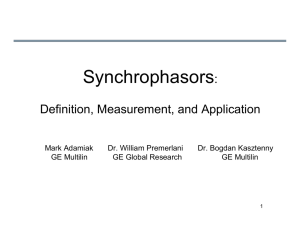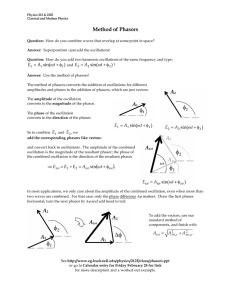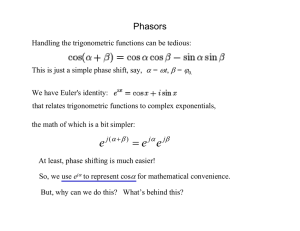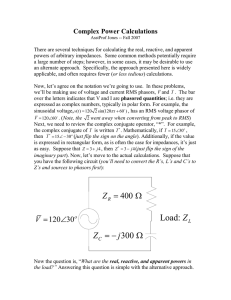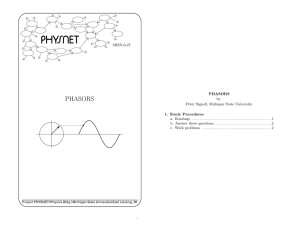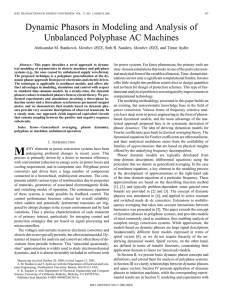Representation of traveling harmonic waves using PHASORS
advertisement
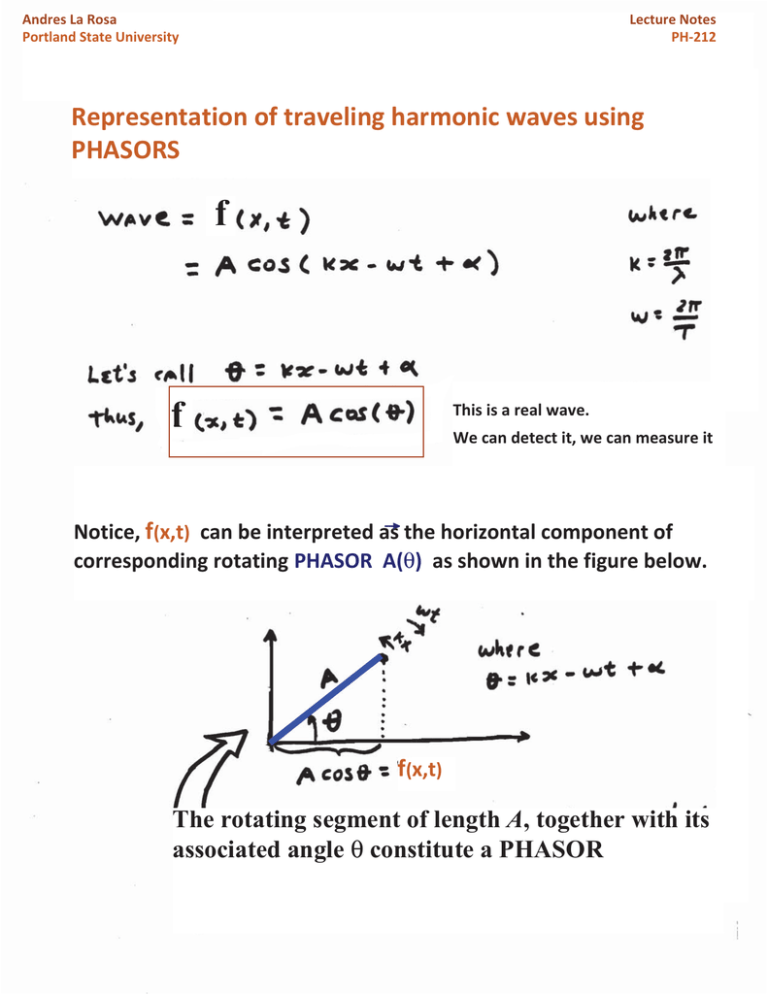
Andres La Rosa
Portland State University
Lecture Notes
PH-212
Representation of traveling harmonic waves using
PHASORS
f
f
This is a real wave.
We can detect it, we can measure it
Notice, f(x,t) can be interpreted ass the horizontal component of
corresponding rotating PHASOR A(θ) as shown in the figure below.
f(x,t)
The rotating segment of length A, together with its
associated angle θ constitute a PHASOR
Addition of waves using the method of phasors
Given
f1 =
f2 =
f2
f1 (x,t)= A1 cos (θ1) =
Horizontal
component of
f2 (x,t)= A2 cos (θ2) =
Horizontal
component of
Horizontal
f1 (x,t) + f2 (x,t) = component
of
A1(θ1)
A1(θ1)
A 2 ( θ 2)
A2(θ2)
In different applications, it is
easier to add up the phasors.
Once the total sum (the phasor
sum) is found, its horizontal
component will be f1 + f2 .
y1
y2
f1
f2
A1(θ1)
A2(θ2)
f1 f2
Work in the phasors world
A1(θ1)
A2(θ2)
this sum will have the form
A(θ)
f1 f2
A(θ)
CASE: Adding two harmonic waves of the
same frequency Z and the same wavelength
O= 2S/k
y1 = A1Cos(kx – Zt +D1) = A1Cos(T1)
y2 = A2Cos(kx – Zt +D2) = A2Cos(T2)
This implies constructing the corresponding phasors
Phasor-1: A1(T1) where T1= kx – Zt +D1
Phasor-2: A2(T2) where T2= kx – Zt +D2
A
D
A1
D1
A2
D2
k Z
Reference
axis
kx -Zt
It is clear, from the graph, that all the phasors rotate
synchronously.
Notice, the graph above reduces to
D
A
A1
A2
D2
D1
Reference
axis
Accordingly,
the problem of adding the phasors
A1(T1) where T1= kx – Zt +D1
and
A2(T2) where T2= kx – Zt +D2
reduces to the addition of the simpler phasors
A1(D1) and A2(D2)
Such sum will have the form
A(D)
where A and D to be determined in terms of A1,
A2 and D2.
D1,
Finding A and D
From the previous figure (re-drawn below)
A
A2
A2
A
D2
A1
D1
Reference
axis
DD
Similarly, also from the figure
α
A
D
A1
D1
A2
D2
Reference
axis
f 1(x,t)
A1=4 mm, and α1 = 0
f 2(x,t)
A2=3 mm, and α2 = π/3
f 1(x,t) + f 2(x,t)
f 1(x,t)
f 2(x,t)
We build a corresponding
phasor A1(0) (see graph.)
A2(π/3)
We build a corresponding
phasor A2(π/3) (see graph.)
A1(0)
We have found,
A1(0) + A2(S/3) = A(D)
where A = 6.1 mm and D = 0.44 rad
A
D
A1
D2
A2
D2 S
Reference
axis
D1 It means
A1(kx -wt + 0) + A2(kx -wt + S/3) = A(kx -wt + D)
D
A
A1
D2
A2
D2 S
kx -Zt
Reference
axis
Going back to the real world,
f1(x,t) + f2(x,t) = Horizontal component of{ A(kx -wt + D)}
= 6.1 mm Cos(kx -wt + 0.44 rad)

